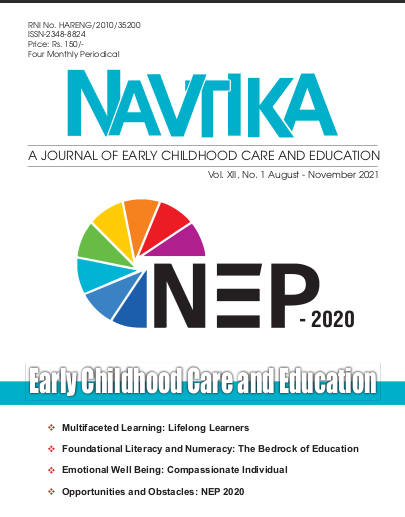Design Thinking as an Inclusive Approach to Education ABSTRACT This paper argues and advocates the use of the Design Thinking approach for school education with a special focus on inclusivity. It demonstrates that inclusivity is at the center of Design Thinking Approach as empathy is its first prerequisite. It bases itself on the seminal work on ‘Design Thinking’ by Tim Brown who Co-Chairs a global design company called IDEO which has created sustainable, successful, and scalable solutions in diverse fields including school education (curriculum design, teacher-training, management-training, designing school buildings keeping in mind the learners’ needs, etc.). The paper evaluates the value of this approach, especially in the context of catering to the needs of the most marginalized, which are often excluded from the process of education. User-centric approach, multiple and rapid Prototyping, Empathy, Feedback, and Iteration are discussed as fundamental pillars of Design Thinking approach which are significant to ensure true inclusivity in the process of education. Innova school networks in Peru have been cited as an important example of the success of this approach in the developing world where still many live under poverty and are grappling with many social evils like class, caste, gender, racism and who are in much need of affordable quality education given the fact that many are not able to access it. INTRODUCTION Primary school education in India has seen a qualitative evolution, with an increased focus on use of progressive pedagogy based on experiential feedback provided by children. However, there are many challenges that need to be addressed to ensure that children from diverse socio-cultural-economic backgrounds are able to access formal education and receive a strong foundation in their early learning experiences. Some concepts and tools come to dominate the public discourse from time to time and influence most activities happening in the public sphere. For example, the ‘Internet’ and the ‘World Wide Web’, have come to disrupt how knowledge is processed and practiced in all fields. These concepts became a global phenomenon because they did not exclude any group, class, race, caste or gender in their use and envisioning. In fact, they enabled inclusion and provided necessary tools which could be accessible to all sections of society. ‘Design Thinking’ is also one such concept which provides a new and inclusive approach to how problems and questions are approached in an inclusive way. The concept of ‘design’ is usually associated with providing aesthetic value to a product. Then what does one mean by discussing it for the inclusive pedagogy and education sector? Design, in the ‘Design Thinking’ construct, is not merely seen as giving form or packaging to a product or service which figures at the downstream of any service, process or product; rather the term ‘design’ here refers to the process of creating meaningful and inclusive solutions to a problem or a challenge. Therefore, Design is not just about creating something that looks good but also about creating something that meets a specific need or fulfils a specific purpose. The ultimate goal of a design in design thinking approach is to create innovative and effective solutions that improve people’s lives by providing them an equal opportunity to get involved and making them equal stakeholders in processes and institutions that affect their lives. The Design Thinking Approach and Inclusive Education Tim Brown in 2008 for the first time introduced the concept of Design Thinking through his article in Harvard Business Review magazine wherein he emphasized that innovation in the modern history has mostly happened through Design Thinking and is not a standalone work of a genius, as is a common myth often propagated through popular media, but teamwork based on sheer hard work in the form of constant iterations based on feedback from the users. He discusses the innovations of the celebrated American scientist Thomas Alva Edison in support of his argument. He says, “…Edison’s genius lay in his ability to conceive of a fully developed marketplace, not simply a discrete device. He was able to envision how people would want to use what he made, and he engineered towards that insight…Edison’s approach was an early example of what is now called “design thinking” – a methodology that imbues the full spectrum of innovation activities with a human-centered design ethos. What Edison was also doing was not thinking about his innovations only for the chosen few, rather he thought about the common users and their needs who were thus far excluded from the imagination of many scientists before him. Brown (2008) describes Design Thinking architecture as non-linear and flexible unlike some conventional milestone-based processes which mostly concentrate on the ‘best learners’ who often achieve the milestones by rote learning and memorization. Such a conventional approach does not take into consideration learners who might be facing lingual, physical, or other forms of cultural barriers in accessing education. In recent years the Design Thinking approach has gained popularity across various industries because it cares about all users, not just a few. Design thinking, in a definitional pursuit, can be understood as a problem-solving approach that emphasizes empathy, human-centered design, experimentation, iteration, and collaboration (Brown, 2008). It has been widely adopted in various fields, including education (see Noel & Liub, 2017 and Koh et al., 2015) to improve the learning experience of students from diverse sections of society. However, its application in pedagogy, particularly in primary school education, is still relatively new but important. It is essential to incorporate design thinking in primary school education as it has the potential to cultivate empathy, creativity, critical thinking, and problem-solving skills among young learners making them more sensitive to diversity around them in terms of language, culture, physical disabilities, gender, etc. Design thinking promotes a student-centered approach to learning. In conventional education models, teachers are the primary source of knowledge, and students are expected to absorb information passively. Students were often seen as a monolith block in the conventional system which did not take into account the disparities amongst them having serious consequences for their
ABSTRACT The ability to read and write, and perform basic operations with numbers, is a necessary foundation and an indispensable pre-requisite for all future schooling and lifelong learning. However, various governmental, as well as non-governmental surveys, indicate that we are currently in a learning crisis: a large proportion of students currently in elementary school – estimated to be over five crores in number – have not attained foundational literacy and numeracy, i.e., the ability to read and comprehend basic text and the ability to carry out basic addition and subtraction with Indian numerals. (NEP 2020). Foundational Literacy and Numeracy While literacy is the ability to read, write, speak and listen in several ways that facilitates to exchange views and thoughts across different stakeholders and know the world view, numeracy helps in developing logical thinking and reasoning strategies in our daily life activities. Literacy is a critical component; if we wish to see that our children are successful in their studies as well as personal and community lives. Numeracy is nevertheless significant in several walks of our lives including sports, cooking, tailoring, shopping etc., concepts like measurement, patterns, time are just a part of calculations in our everyday life. Hence literacy and numeracy become essential skills to achieve success in life. This emphasis can clearly be seen in the National Education Policy, 2020 when it states, ‘The rest of this Policy will become relevant for our students only if this most basic learning requirement is first achieved’. Research studies have revealed that once children fall behind on foundational literacy and numeracy, they tend to maintain flat learning curves for years, perpetually unable to catch up. For many children, this has become a major reason for not attending school, or for dropping out altogether. At the same time, teachers have explained the extreme difficulty they currently face in covering the syllabus while also paying attention to the large numbers of students who have fallen behind over a good period. Achieving foundational literacy and numeracy for all children must become an immediate national mission. Foundational learning accounts for children’s ability to read and meaningfully comprehend, as well as using basic mathematical operations in real life. India is facing a learning crisis and various national and international surveys, point to the low and in some cases declining learning levels. In the last two decades, we have reached near universal access to schooling (enrolment for children aged six- fourteen years is ninety five percent). However, learning levels have remained consistently low. Most of the foundational skills are acquired in grades I and II, where children ‘learn to read’. Literacy is a critical foundation of education- across cultures, countries and people. Since ensuring that all people have access to literacy is so vital, researchers have invested considerable time and effort in studying how children learn to read and what teachers can do to help them learn to read better. Today we are living in a world that is continuously talking, yet we are not hearing these conversations necessarily and fully. With technology being a major part of our lives, much of our communication is typed and silent and we are relatively more distracted and diverted. This is leading to creating gaps in acquiring fundamental skills especially by young children. As a result, children remain behind on their literacy capabilities at the initial phase of their education. In order to make sure that this pattern does not continue and learning gaps are filled at the earliest, there is a need for exploring such innovations which are context based and can be customised as per the classroom needs. Literacy is the mainstay of all education. Without a correct and clear understanding of language, communication and writing skills, it is almost impossible for children to succeed in their educational journey. The situation becomes more precarious in the education systems like ours that heavily depend on standardized assessment and standardized assessment relies so profoundly on writing. Another serious point related to literacy is that children can often fall behind at the beginning of their literacy lessons if they miss out on a basic communication step which is ‘spoken communication’. This skill is more quickly and naturally learnt through interaction with parents and other people surrounding the child in early life. Though there is nothing new about the importance of spoken communication, but in today’s world, we are observing the beginning of declining skills in this area and it has been caused by the rise of technology which has majorly impacted the life of young children today. CHATTA APPROACH Chatta is a teaching approach which involves training, software and resources for educators to help improve literacy through linking words and images and creating audio-visual storyboards. Through linking experiences and subject content with modelled language and oral rehearsal, students of all ages can think, speak and write at length and in depth. ‘Teachers create audio- visual storyboards which are shared with students,’ explains Williams. ‘The approach has been designed to mirror the way people think and can be used both in classrooms and at home. The audio-visual cues of Chatta strengthen long term memory and make it effortless for children and young people to speak, write and express their thoughts. The exposure to strong models of language makes it easy to understand deeper language and vocabulary when reading and to apply it when writing.’ The impact of Chatta has been phenomenal. Educators using Chatta’s approach have seen children, who had previously been unable to talk, developing fluent speech. A randomised control trial concluded that children who experienced Chatta’s approach made significantly greater progress than those who did not use the Chatta approach.









